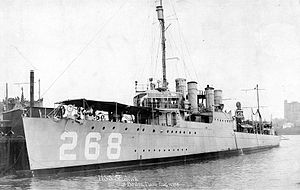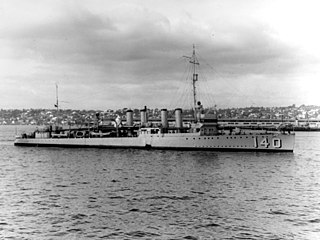
USS Claxton (DD-140), named for Thomas Claxton, was a Wickes-class destroyer in the United States Navy. Entering service in 1919, the destroyer saw intermittent use during the interwar period. During World War II, Claxton was transferred to the Royal Navy and renamed HMS Salisbury. The ship saw service in the Battle of the Atlantic before sold for scrapping in 1944.

The first ship named in honor of Rear Admiral Aaron Ward, USS Aaron Ward (DD-132) was a Wickes-class destroyer in service with the United States Navy. In 1940, she was transferred to the Royal Navy and renamed HMS Castleton.
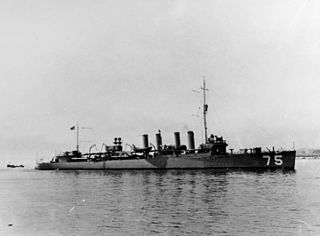
The first USS Wickes (DD-75) was the lead ship of her class of destroyers in the United States Navy during World War I, later transferred to the Royal Navy as HMS Montgomery. She has been the only ship of the Royal Navy to bear the name Montgomery.
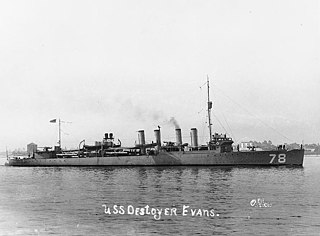
The first USS Evans (DD–78) was a Wickes-class destroyer in the United States Navy during World War I, later transferred to the Royal Navy as HMS Mansfield.

USS Ringgold (DD-89) was a Wickes-class destroyer in the United States Navy during World War I and the interwar period. During World War II, the vessel was transferred to the Royal Navy as a Town-class destroyer named HMS Newark, being scrapped after the end of the war in 1947.

The first USS Twiggs (DD–127) was a Wickes-class destroyer in the United States Navy during World War I. She was named for Major Levi Twiggs. She was later transferred to the Royal Navy, as HMS Leamington and to the Soviet Navy as Zhguchy, before returning to Britain to star in the film The Gift Horse, which depicts the St. Nazaire Raid.

USS Crowninshield (DD–134) was a Wickes-class destroyer in the United States Navy between World War I and World War II. She was named for Benjamin Williams Crowninshield. In World War II she was transferred to the Royal Navy where she was named HMS Chelsea, and subsequently to the Soviet Navy where she was named Derzky.

The first USS Yarnall (DD–143) was a Wickes-class destroyer in the United States Navy during World War I later transferred to the Royal Navy as HMS Lincoln, to the Royal Norwegian Navy as HNoMS Lincoln, and subsequently to the Soviet Navy as Druzhny.

USS Maddox (DD–168) was a Wickes-class destroyer in the United States Navy during World War I. She was later transferred to the Royal Navy as HMS Georgetown (I-40), to the Royal Canadian Navy as HMCS Georgetown, and then to the Soviet Navy as Doblestny . She was the last "four piper" destroyer to be scrapped.

The first USS Kalk (DD–170) was a Wickes-class destroyer in the United States Navy during World War I, later transferred to the Royal Navy as HMS Hamilton (I24) and then into the Royal Canadian Navy as HMCS Hamilton (I24).

USS Welborn C. Wood (DD-195) was a Clemson-class destroyer in the United States Navy during World War II. She served with the United States Coast Guard as USCGD Wood. She was later transferred to the Royal Navy as HMS Chesterfield.

USS Branch (DD-197) was a Clemson-class destroyer in the United States Navy that entered service in 1920. After a short active life, Branch was placed in reserve in 1922. The ship was activated again for World War II before being transferred to the Royal Navy in 1940. Renamed HMS Beverley, the destroyer served in the Battle of the Atlantic as a convoy escort and was torpedoed and sunk on 11 April 1943.
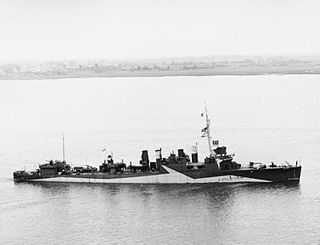
USS Herndon (DD-198) was a Clemson-class destroyer in the United States Navy. Herndon served in the United States Coast Guard as CG-17. She was later transferred to the Royal Navy as HMS Churchill and still later to the Soviet Navy as Deyatelny.
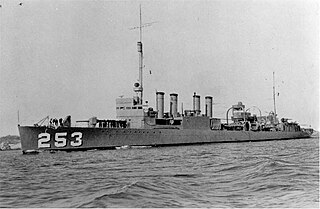
The first USS McCalla (DD-253) was a Clemson-class destroyer in the United States Navy. She transferred to the Royal Navy as HMS Stanley (I73) during World War II.
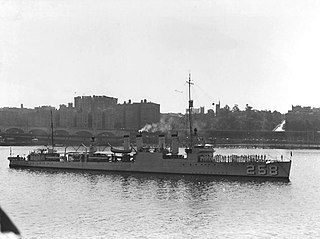
The second USS Aulick (DD-258) was a Clemson-class destroyer in the United States Navy and transferred to the Royal Navy where she served as HMS Burnham (H82) during World War II.

The first USS Laub (DD-263) was a Clemson-class destroyer in the United States Navy and transferred to the Royal Navy where she served as HMS Burwell (H94) during World War II. She was named for Henry Laub.

The first USS McLanahan (DD-264) was a Clemson-class destroyer in the United States Navy and transferred to the Royal Navy where she served as HMS Bradford (H72) during World War II.

USS Edwards (DD-265) was a Clemson-class destroyer in the United States Navy and transferred to the Royal Navy where she served as HMS Buxton (H96) and later in the Royal Canadian Navy during World War II.

The first USS Swasey (DD-273) was a Clemson-class destroyer in the United States Navy and transferred to the Royal Navy as HMS Rockingham (G58).

HMS Ekins (K552) was a British Captain-class frigate of the Royal Navy that served during World War II. Originally constructed as a United States Navy Buckley class destroyer escort, she served in the Royal Navy from 1943 to 1945.
